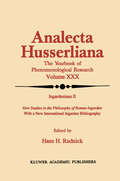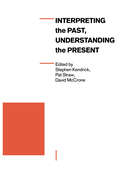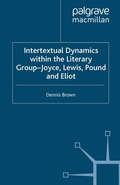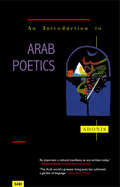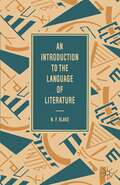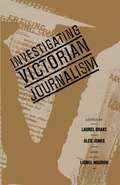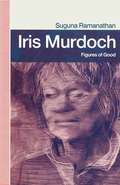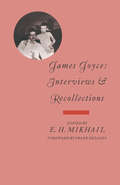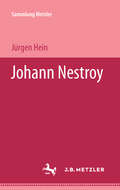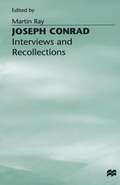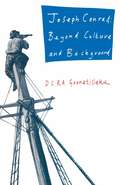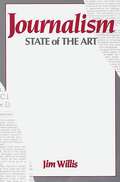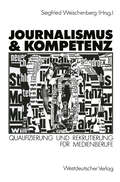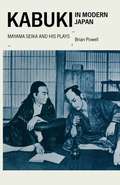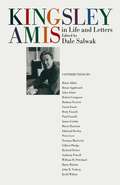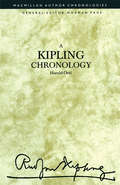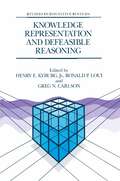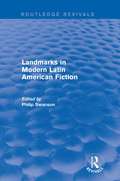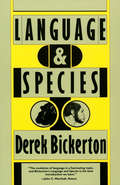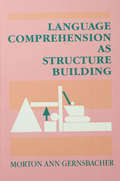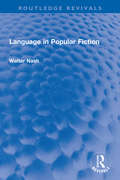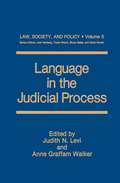- Table View
- List View
Ingardeniana II: New Studies in the Philosophy of Roman Ingarden With a New International Ingarden Bibliography (Analecta Husserliana #30)
by Hans H. RudnickThis Ingardenia volume is the second in the Analecta Husserliana series that is entirely devoted to the phenomenology of Roman Ingarden. The first was volume IV (1976). Twenty years after Ingarden's death, this volume demonstrates that the Polish phenomenologist's contribution to philosophy and literary scholarship has received world-wide attention. His ideas have proven especially fruitful for the definition of the structure of the literary work of art and the subsequent recognition of its characteristic features. Of all the early phenomenologists who were students of Husserl, it is Ingarden whose work has faithfully pursued the original tenet that language "holds" the essence of the life-world "in readiness" (bereit halten). To investigate this premise with the rigor of a science, as Husserl had envisioned for phenomenology, was Ingarden's life work. That Ingarden did not quite reach his ambitious goal does not diminish his unquestionable achievement. The understanding of the nature of the literary work of art has increased enormously because of his analyses and aesthetics. The Polish phenomenologist investigated above all the work of art as a structure of necessary components which define and determine its nature. That the artistic ingredient was shortchanged under those conditions should not be surprising, particu larly since Ingarden usually kept a purist's philosophical distance from the concrete detail of the material under consideration. He was not concerned with individual works of art but with the principle that was shared by all of them as the defining feature of their being.
Interpreting the Past, Understanding the Present (Explorations in Sociology.)
by Stephen Kendrick David McCrone Pat StrawThe British Sociological Association held a conference on the theme "Sociology and History". In 1964, E.H. Carr had called for an open frontier between the disciplines. This book examines the traffic across this frontier and in particular, what might be called the sociological uses of history.
Intertextual Dynamics within the Literary Group of Joyce, Lewis, Pound and Eliot: The Men of 1914
by D. BrownThe book examines key texts by the writers James Joyce, Wyndham Lewis, Ezra Pound and T.S. Eliot as moves within a shared group-game - that of creating a new literature for the new age. It maps a great deal of intertextual reference, allusion and influence and suggests a psychoanalytically-informed hypothesis that certain literature can be constituted a species of interpersonal groupwork. It demonstrates how the core grouping within literary modernism developed an experimental discourse through mutual rivalry and sharing. And it describes different group roles, contributions and changes of emphasis within an overall project stretching from 1914 into the 1950s.
An Introduction to Arab Poeti
by AdonisPoetry is the quintessence of Arab culture. In this book, one of the foremost Arab poets reinterprets a rich and ancient heritage. He examines the oral tradition of pre-Islamic Arabian poetry, as well as the relationship between Arabic poetry and the Qur'an, and between poetry and thought. Adonis also assesses the challenges of modernism and the impact of western culture on the Arab poetic tradition. Stimulating in their originality, eloquent in their treatment of a wide range of poetry and criticism, these reflections open up fresh perspectives on one of the world's greatest - and least explored - literatures. 'The most intellectually stimulating of several Arab books of unique literary distinction in fine translations ... Translated with uncommon intelligence ... As important a cultural manifesto as any written today.' Edward Said, Independent on Sunday 'Adonis's only prose work available in English is this book. The loss is ours and it is massive, for Adonis is a writer like Neruda or Marquez.' Geoff Dyer, Independent 'Introduces the reader to a new way of interpreting all poetry, and to many marvellous words that do not have an English equivalent.' Arts Letter
An Introduction to the Language of Literature (The Language of Literature)
by Norman BlakeThis book presents an introduction to stylistics for students of literature. It does not presuppose linguistic knowledge, but it approaches literature in a linguistic way. In the first half it looks at the make-up of a sentence in English and how sentence elements are exploited by literary authors. In the second half it looks at the way in which a text is unified by elements beyond the sentence. The conclusion exemplifies the theory explained in the previous chapters.
Johann Nestroy (Sammlung Metzler)
by Jürgen HeinDer Band zeichnet die Züge eines bedeutenden Zeitgenossen des 19. Jahrhunderts nach, dessen Leben als Sänger, Schauspieler und Direktor im Theater aufging.
Joseph Conrad: Interviews and Recollections (Interviews and Recollections)
by Martin RayThese 60 recollections present some of the many facets of Conrad the writer, the adventurer and the recluse, the Polish gallant and the neurotic modernist, the Edwardian country gentleman and the penniless beggar.
Joseph Conrad: Beyond Culture and Background (Routledge Guides To Literature Ser.)
by D C Goonetilleke Caterina SinibaldiJournalism: State of the Art
by Jim WillisA necessity for the professional journalist's library, Journalism: State of the Art will prove a valuable resource for the student journalist as well. This book summarizes some 200 media studies many from the most prestigious journal in the trade, Journalism Quarterly. In a paraphrased-synthesis format, and using informal terms, the author arranges some of the most interesting studies of the 1980s into eight subject headings including: Ethics Law, and the Journalist; Advertising in the 1980s; Polling and Precision Journalism; and Predictors of Readership and Viewship.For many years there has been a gap between media researchers and the practicing journalist. Published research about journalism as a discipline may receive attention in the classroom but seldom gets in the newsroom. Viewing the gap between the researcher and practitioner, Willis offers comments from both sides. He surveys nearly 150 news executives on media research and gives an insightful look at what factors cause readers or viewers to pay attention to the news media. From trends in the industry to types of audiences, Journalism: State of the Art uses practical research studies presented in an accessible style. Offering the most current data available on media research, this book will prove a great instructional as well as reference tool. It is a must for college journalists, working press, and media marketers.
Journalismus & Kompetenz: Qualifizierung und Rekrutierung für Medienberufe
by Siegfried WeischenbergDie Qualifizierung und Rekrutierung für Medienberufe enthält im Prozeß sozialen Wandels zu einer "Informationsgesellschaft" besondere Bedeutung. Was müssen Journalisten wissen und können, um den gestiegenen Ansprüchen an ihre Kompetenz gerecht zu werden? Wie können sich Berufsaspiranten am besten auf den Journalismus vorbereiten? Welche Vorzüge und Nachteile haben die Ausbildungswege in die Medien? Diese Fragen werden in den 15 Originalbeiträgen des Readers beantwortet. Sie enthalten nicht nur Informationen, sondern erstmals auch (empirische) Evaluationen zu allen Formen der Journalistenausbildung in der Bundesrepublik. Themen sind u.a. die in Stellenanzeigen nachgefragten Qualifikationen, die Weiterbildungsangebote für Journalisten, die Didatik der Journalistenausbildung, die Qualität der Lehrbücher zum Journalismus und die Berufschancen von Publizistik-Studenten."(...) Dem vorliegenden Reader ist das Erreichen seiner Zielsetzung voll zu bescheinigen. Er leistet - und das unterscheidet ihn durchaus von anderen einschlägigen Publikationen - eine weitreichende Problematisierung sowie vor allem empirisch gestützte Evaluation der Qualifizierung für die Medien und arbeitet damit einen bedeutenden Defizitbereich der Forschung auf. Trotz der Vielfalt der behandelten Einzelthemen bleibt der Problemzugriff insgesamt doch kohärent, was durch häufige Querverweise unterstützt wird. Berufsaspiranten, aber auch die Ausbilder selbst sollten nicht von der Lektüre dieses wichtigen Beitrags absehen."Medienwissenschaft 1/91"(...) Das Buch empfiehlt sich nicht nur für Berufsaspiranten, die sich über die diversen Ausbildungswege ein Bild verschaffen wollen, sondern auch für Journalisten, die nach Ergänzungen suchen und die Anregungen zur Reflexion über die Bedingungen ihres Berufes erwarten."Medium 1/92
Knowledge Representation and Defeasible Reasoning (Studies in Cognitive Systems #5)
by Henry E. Kyburg Jr. R. P. Loui G. N. CarlsonThis series will include monographs and collections of studies devoted to the investigation and exploration of knowledge, information, and data processing systems of all kinds, no matter whether human, (other) ani mal, or machine. Its scope is intended to span the full range of interests from classical problems in the philosophy of mind and philosophical psy chology through issues in cognitive psychology and sociobiology (concerning the mental capabilities of other species) to ideas related to artificial intelli gence and computer science. While primary emphasis will be placed upon theoretical, conceptual, and epistemological aspects of these problems and domains, empirical, experimental, and methodological studies will also ap pear from time to time. The present volume provides a collection of studies that focus on some of the central problems within the domain of artificial intelligence. These difficulties fall into four principal areas: defeasible reasoning (including the frame problem as apart), ordinary language (and the representation prob lems that it generates), the revision of beliefs (and its rules of inference), and knowledge representation (and the logical problems that are encountered there). These papers make original contributions to each of these areas of inquiry and should be of special interest to those who understand the crucial role that is played by questions of logical form. They vividly illustrate the benefits that can emerge from collaborative efforts involving scholars from linguistics, philosophy, computer science, and AI. J. H. F.
Landmarks in Modern Latin American Fiction (Routledge Revivals)
by Philip SwansonIn the 1960s, there occurred amongst Latin American writers a sudden explosion of literary activity known as the ‘Boom’. It marked an increase in the production and availability of innovative and experimental novels. But the ‘Boom’ of the 1960s should not be taken as the only flowering of Latin American fiction, for such novels dubbed ‘new novels’ were being written in the 1940s and 1950s, as well as in the 1970s and 1980s. In this edited collection, first published in 1990, Philip Swanson charts the development of Latin American fiction throughout the twentieth century. He assesses the impact of the ‘new novel’ on Latin American literature, and follows its growth. Nine key texts are analysed by contributors, including works by the ‘big four’ of the ‘Boom’ – Fuentes, Cortázar, Garcia Márquez and Vargas Llosa. This book will be of interest to critics and teachers of Latin American literature, and will be useful too as supplementary reading for students of Spanish and Hispanic Studies. It will also serve as a helpful introduction to those new to Latin American fiction.
Landmarks in Modern Latin American Fiction (Routledge Revivals)
by Philip SwansonIn the 1960s, there occurred amongst Latin American writers a sudden explosion of literary activity known as the ‘Boom’. It marked an increase in the production and availability of innovative and experimental novels. But the ‘Boom’ of the 1960s should not be taken as the only flowering of Latin American fiction, for such novels dubbed ‘new novels’ were being written in the 1940s and 1950s, as well as in the 1970s and 1980s. In this edited collection, first published in 1990, Philip Swanson charts the development of Latin American fiction throughout the twentieth century. He assesses the impact of the ‘new novel’ on Latin American literature, and follows its growth. Nine key texts are analysed by contributors, including works by the ‘big four’ of the ‘Boom’ – Fuentes, Cortázar, Garcia Márquez and Vargas Llosa. This book will be of interest to critics and teachers of Latin American literature, and will be useful too as supplementary reading for students of Spanish and Hispanic Studies. It will also serve as a helpful introduction to those new to Latin American fiction.
Language and Species
by Derek BickertonLanguage and Species presents the most detailed and well-documented scenario to date of the origins of language. Drawing on "living linguistic fossils" such as "ape talk," the "two-word" stage of small children, and pidgin languages, and on recent discoveries in paleoanthropology, Bickerton shows how a primitive "protolanguage" could have offered Homo erectus a novel ecological niche. He goes on to demonstrate how this protolanguage could have developed into the languages we speak today. "You are drawn into [Bickerton's] appreciation of the dominant role language plays not only in what we say, but in what we think and, therefore, what we are."—Robert Wright, New York Times Book Review "The evolution of language is a fascinating topic, and Bickerton's Language and Species is the best introduction we have."—John C. Marshall, Nature
Language Comprehension As Structure Building
by Morton Ann GernsbacherThis book presents a new theoretical framework -- what Gernsbacher calls the Structure Building Framework -- for understanding language comprehension in particular, and cognitive processing in general. According to this framework, the goal in comprehending both linguistic and nonlinguistic materials is to build a coherent mental representation or "structure" of the information being comprehended. As such, the underlying processes and mechanisms of structure building are viewed as general, cognitive processes and mechanisms. The strength of the volume lies in its empirical detail: a thorough literature review and solid original data.
Language Comprehension As Structure Building
by Morton Ann GernsbacherThis book presents a new theoretical framework -- what Gernsbacher calls the Structure Building Framework -- for understanding language comprehension in particular, and cognitive processing in general. According to this framework, the goal in comprehending both linguistic and nonlinguistic materials is to build a coherent mental representation or "structure" of the information being comprehended. As such, the underlying processes and mechanisms of structure building are viewed as general, cognitive processes and mechanisms. The strength of the volume lies in its empirical detail: a thorough literature review and solid original data.
Language in Popular Fiction (Routledge Revivals)
by Walter NashFirst published in 1990, Language in Popular Fiction was written to provide a comprehensive and illuminating look at the way language is used in thrillers and romantic fiction. The book examines the use of language across three interrelated levels: a level of verbal organisation, a level of narrative structure, and a level at which stylistic options and devices are related to notions of gender. It introduces ‘the protocol of pulchritude’ and makes use of detailed stylistic and linguistic analysis to investigate a wide range of ‘popfiction’ and ‘magfiction’. In doing so, it provokes serious reflection on popular fiction and its claims on the reader.
Language in Popular Fiction (Routledge Revivals)
by Walter NashFirst published in 1990, Language in Popular Fiction was written to provide a comprehensive and illuminating look at the way language is used in thrillers and romantic fiction. The book examines the use of language across three interrelated levels: a level of verbal organisation, a level of narrative structure, and a level at which stylistic options and devices are related to notions of gender. It introduces ‘the protocol of pulchritude’ and makes use of detailed stylistic and linguistic analysis to investigate a wide range of ‘popfiction’ and ‘magfiction’. In doing so, it provokes serious reflection on popular fiction and its claims on the reader.
Language in the Judicial Process (Law, Society and Policy #5)
by Judith N. Levi Anne Graffam WalkerLegal realism is a powerful jurisprudential tradition which urges attention to sodal conditions and predicts their influence in the legal process. The rela tively recent "sodal sdence in the law" phenomenon, in which sodal research is increasingly relied on to dedde court cases is a direct result of realistic jurisprudence, which accords much significance in law to empirical reports about sodal behavior. The empirical research used by courts has not, how ever, commonly dealt with language as an influential variable. This volume of essays, coedited by Judith N. Levi and Anne Graffam Walker, will likely change that situation. Language in the Judicial Process is a superb collection of original work which fits weIl into the realist tradition, and by focusing on language as a key variable, it establishes a new and provocative perspective on the legal process. The perspective it offers, and the data it presents, make this volume a valuable source of information both for judges and lawyers, who may be chiefly concemed with practice, and for legal scholars and sodal sdentists who do basic research about law.
